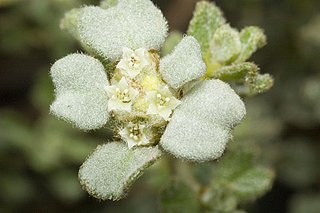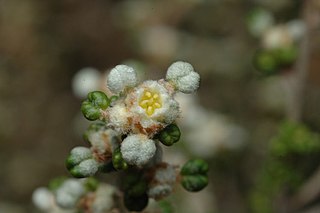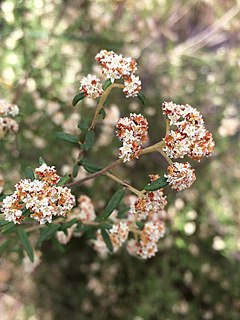
Leptospermum trinervium, commonly known as flaky-barked tea-tree, slender tea-tree or paperbark tree, is a species of shrub or small tree that is endemic to eastern Australia. It has papery bark that is shed in thin, flaking layers, narrow elliptic to broadly egg-shaped leaves with the narrower at the base, white flowers and silky-hairy fruit that falls from the plant when mature.

Cryptandra amara, commonly known as bitter cryptandra or pretty pearlflower, is a species of flowering plant in the family Rhamnaceae and is endemic to eastern Australia. It is a densely-branched shrub with clustered, more or less linear to egg-shaped or elliptic leaves, and tube-shaped white flowers arranged on the ends of branchlets.
Pomaderris briagolensis is a species of flowering plant in the family Rhamnaceae and is endemic to Victoria, Australia. It is a shrub with hairy branchlets, egg-shaped or oblong leaves and panicles of white to rust-coloured flowers.

Spyridium bifidum, commonly known as forked spyridium, is a species of flowering plant in the family Rhamnaceae and is endemic to South Australia. It is an erect shrub with densely softly-hairy young stems, wedge-shaped to linear leaves sometimes with a two-lobed tip, and densely woolly heads of white-velvety flowers.

Spyridium scortechinii is a species of flowering plant in the family Rhamnaceae and is endemic to eastern Australia. It is a shrub with egg-shaped to narrowly elliptic leaves, and dense heads of white, woolly-hairy flowers with brown bracts at the base.
Spyridium coalitum is a species of flowering plant in the family Rhamnaceae and is endemic to Kangaroo Island in South Australia. It is a slender, erect shrub with softly-hairy young stems, oblong to narrowly elliptic leaves, and head of white to cream-coloured flowers.
Spyridium fontis-woodii, commonly known as Woods Well spyridium, is a species of flowering plant in the family Rhamnaceae and is endemic to a small area of Coorong National Park in South Australia. It is a slender shrub with softly-hairy young stems, broadly egg-shaped to broadly heart-shaped leaves with the narrower end towards the base, and head of white to cream-coloured flowers.

Spyridium furculentum, commonly known as forked spyridium, is a species of flowering plant in the family Rhamnaceae and is endemic to a small area of Victoria in Australia. It is a shrub with softly-hairy young stems, Y-shaped leaves, and head of white to cream-coloured flowers.
Spyridium glaucum is a species of flowering plant in the family Rhamnaceae and is endemic to a restricted area of south-western Western Australia. It is an erect or spreading shrub with egg-shaped leaves, and clusters of 3 to 6 rusty-hairy flowers.

Spyridium halmaturinum, commonly known as Kangaroo Island spyridium, is a species of flowering plant in the family Rhamnaceae and is endemic to Kangaroo Island in South Australia. It is an erect, sticky shrub with densely softly-hairy young stems, leaves that are heart-shaped with the narrower end towards the base to broadly wedge-shaped or Y-shaped, and dense heads of white to cream-coloured flowers.

Spyridium lawrencei, commonly known as small-leaf spyridium or small-leaf dustymiller, is a species of flowering plant in the family Rhamnaceae and is endemic to Tasmania. It is an erect, compact or straggling shrub with small, leathery, round to heart-shaped leaves, and dense heads of hairy, cream-coloured flowers.
Spyridium minutum is a species of flowering plant in the family Rhamnaceae and is endemic to the south of Western Australia. It is an erect or spreading shrub with broadly egg-shaped or heart-shaped leaves, and groups of two or three hairy, white flowers.
Spyridium mucronatum is a species of flowering plant in the family Rhamnaceae and is endemic to the south of Western Australia. It is an erect or spreading shrub usually with narrowly oblong leaves, and dense clusters of up to ten densely hairy, white to yellow flowers.
Spyridium nitidum, commonly known as shining spyridium, is a species of flowering plant in the family Rhamnaceae and is endemic to south-eastern continental Australia. It is an erect, spindly shrub with narrowly elliptic or narrowly egg-shaped leaves with the narrower end towards the base, and heads of hairy, woolly white flowers.
Cryptandra congesta is a flowering plant in the family Rhamnaceae and is endemic to a restricted area of the south-west of Western Australia. It is a low, spreading shrub with narrowly egg-shaped or narrowly oblong leaves and clusters of white, tube-shaped flowers.
Spyridium × ramosissimum, commonly known as branched spyridium, is a species of flowering plant in the family Rhamnaceae and is endemic to Victoria in Australia. It is a small shrub with woolly-hairy branches, egg-shaped leaves, and crowded heads of hairy flowers with brown bracts.

Spyridium riparium is a species of flowering plant in the family Rhamnaceae and is endemic to the south of Western Australia. It is an erect shrub, usually with narrowly egg-shaped leaves, and clusters of densely hairy, white or cream-coloured flowers.
Cryptandra craigiae is a flowering plant in the family Rhamnaceae and is endemic to a restricted area of southern Western Australia. It is a shrub with linear leaves and dense clusters of white or cream-coloured, tube-shaped flowers.

Spyridium spadiceum is a species of flowering plant in the family Rhamnaceae and is endemic to the south of Western Australia. It is an erect or semi-prostrate shrub with narrowly oblong to oval leaves and heads of hairy flowers with brown bracts at the base.
Cryptandra dielsii is a flowering plant in the family Rhamnaceae and is endemic to the south-west of Western Australia. It is a spreading shrub with linear to narrowly oblong leaves and dense clusters of white, hairy, tube-shaped flowers.








